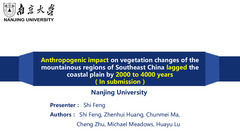报告详情
Anthropogenic impact on vegetation of the mountainous regions of Southeast China lagged changes in the coastal plain by 2000 to 3000 years
编号:2651
访问权限:私有
更新:2023-04-11 22:43:51 浏览:849次
口头报告

报告开始:2023年05月07日 15:55(Asia/Shanghai)
报告时间:10min
所在会场:[17A] 17A、古生物、古地理与古环境 [17A-2] 17A-2 古生物、古地理与古环境
摘要
Understanding the relationships between anthropogenic impact, vegetation and climate change offers valuable insights for human society adaptation to climate change in the context of global warming. While increased human impact on the coastal plain of southeast China is relatively well studied, understanding of anthropogenic activities and their impacts in the mountain regions is still lacking in the Holocene.
Here we present a high-resolution vegetation, fire and human impact record spanning the past 4600 years with ~47 years resolution from a mountain in southeast China based on geophysical, geochemical, palynological and charcoal analysis supported by a robust AMS 14C chronology.Result shows that the vegetation and climate proceeded in three phases as follows: study area was warm and wet during 4.6-3.7 cal kyr BP, which promoted abundant evergreen and deciduous broad-leaved mixed forest; from 3.7 to 1.0 cal kyr BP, the evergreen broad-leaved forest declined and deciduous broad-leaved forest increased in response to reduced precipitation arising from weakening of the EASM; coniferous forest replaced broad-leaved forest and pollen associated with human activities (e.g. Poaceae<37um, Poaceae≥37um, Artemisia, Aster, Asteraceae) significant increased after 1.0 cal kyr BP. This last phase coincides with the Song Dynasty and is associated with enhanced human activities in the study areas as population migrated from northern to southern China in order to avoid conflict following the ‘Five Generations and Ten Kingdoms’ period.
Before 1.0 cal kyr BP, climate change, dominated by dynamics of the EASM underpinned by variations in solar radiation and the position of Intertropical Convergence Zone (ITCZ), was the most important factor controlling vegetation. Human impact gradually emerged as the major driver after 1000 yr BP in the mountains of southeast China. The recorded changes lag those previously reported in the coastal plain by 2000~3000 years. As the population migrating from northern China dispersed into the more mountainous regions, the need for arable land promoted slash-and-burn cultivation and the destruction of broad-leaved forest vegetation. Additionally, the development of mining, smelting, porcelain and jade industries also increased the degree of deforestation in the last 1000 years and significantly altered the composition of vegetation in the mountains of southeast China.
Here we present a high-resolution vegetation, fire and human impact record spanning the past 4600 years with ~47 years resolution from a mountain in southeast China based on geophysical, geochemical, palynological and charcoal analysis supported by a robust AMS 14C chronology.Result shows that the vegetation and climate proceeded in three phases as follows: study area was warm and wet during 4.6-3.7 cal kyr BP, which promoted abundant evergreen and deciduous broad-leaved mixed forest; from 3.7 to 1.0 cal kyr BP, the evergreen broad-leaved forest declined and deciduous broad-leaved forest increased in response to reduced precipitation arising from weakening of the EASM; coniferous forest replaced broad-leaved forest and pollen associated with human activities (e.g. Poaceae<37um, Poaceae≥37um, Artemisia, Aster, Asteraceae) significant increased after 1.0 cal kyr BP. This last phase coincides with the Song Dynasty and is associated with enhanced human activities in the study areas as population migrated from northern to southern China in order to avoid conflict following the ‘Five Generations and Ten Kingdoms’ period.
Before 1.0 cal kyr BP, climate change, dominated by dynamics of the EASM underpinned by variations in solar radiation and the position of Intertropical Convergence Zone (ITCZ), was the most important factor controlling vegetation. Human impact gradually emerged as the major driver after 1000 yr BP in the mountains of southeast China. The recorded changes lag those previously reported in the coastal plain by 2000~3000 years. As the population migrating from northern China dispersed into the more mountainous regions, the need for arable land promoted slash-and-burn cultivation and the destruction of broad-leaved forest vegetation. Additionally, the development of mining, smelting, porcelain and jade industries also increased the degree of deforestation in the last 1000 years and significantly altered the composition of vegetation in the mountains of southeast China.
关键词
The mountain of Southeast China; Anthropocene; pollen; 1000 year ago (Song Dynasty); enhanced human activities; vegetation Change
报告人

冯时
硕士研究生 南京大学稿件作者
全部评论
重要日期
-
会议日期
05月05日
2023
至05月08日
2023
-
03月31日 2023
初稿截稿日期
-
05月25日 2023
注册截止日期
主办单位
青年地学论坛理事会
中国科学院青年创新促进会地学分会
中国科学院青年创新促进会地学分会
承办单位
武汉大学
中国科学院精密测量科学与技术创新研究院
中国地质大学(武汉)
中国科学院精密测量科学与技术创新研究院
中国地质大学(武汉)


发表评论